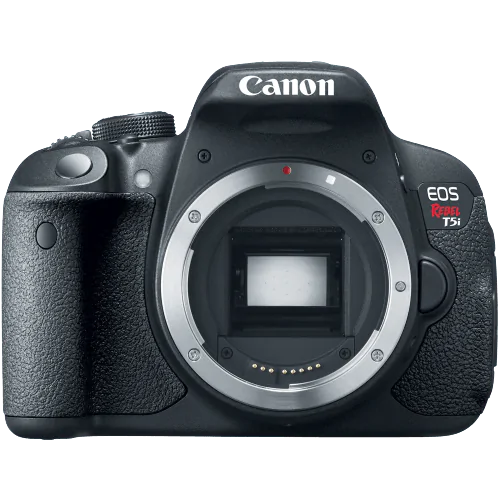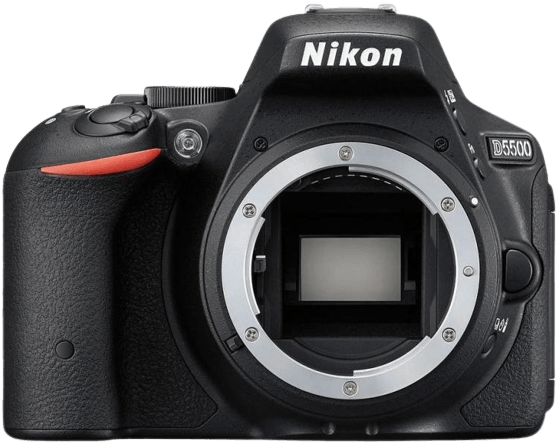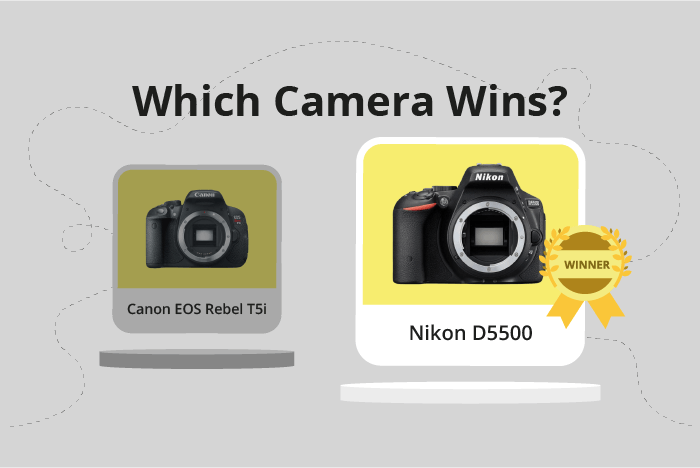Canon EOS Rebel T5i / 700D vs Nikon D5500 Comparison
Canon EOS Rebel T5i / 700D

Nikon D5500

The Nikon D5500 emerges as the winner with a score of 61/100, outperforming the Canon EOS Rebel T5i / 700D, which scored 44/100. Both cameras are DSLRs, released in 2013 and 2015, respectively. They share some specifications, such as their camera type and similar launch prices ($750 and $900).
The Nikon D5500 surpasses the Canon T5i in terms of size and weight, measuring 124 x 97 x 70mm and weighing 420g, making it more compact and lighter than the Canon T5i, which measures 133 x 100 x 79mm and weighs 580g. The Canon T5i, however, has the advantage of being more affordable, with a $150 lower launch price than the Nikon D5500.
Considering these factors, the Nikon D5500 proves to be a better choice for those seeking a compact and lightweight DSLR, while the Canon T5i is a budget-friendly option for those prioritizing affordability.
Canon EOS Rebel T5i / 700D vs Nikon D5500 Overview and Optics
The Nikon D5500 wins the optics comparison with a score of 65 out of 100, while the Canon EOS Rebel T5i / 700D scores 40 out of 100. Both cameras share several specifications, including a CMOS sensor type, APS-C sensor size, 5 shooting speed, no image stabilization, and lens mounts specific to their respective brands (Canon EF-S and Nikon F DX).
The Nikon D5500 boasts a higher megapixel count at 24.2, compared to the Canon T5i’s 18 megapixels. This difference allows the Nikon D5500 to capture more detail and produce higher resolution images. Additionally, the Nikon D5500 has a superior DXOMARK score for the sensor at 84, compared to the Canon T5i’s 61. This higher score means the Nikon D5500 has better overall image quality, particularly in low-light situations and dynamic range.
The Canon T5i, on the other hand, has a Digic 5 processor, while the Nikon D5500 uses an Expeed 4 processor. However, this difference does not provide a significant advantage for the Canon T5i in terms of optics.
Considering the higher megapixel count and better DXOMARK score, the Nikon D5500 is the superior choice for optics. The Canon EOS Rebel T5i / 700D does not have any specific advantages in this area, making the Nikon D5500 the clear winner in terms of image quality and detail.
Canon EOS Rebel T5i / 700D vs Nikon D5500 Video Performance
The Nikon D5500 outperforms the Canon EOS Rebel T5i / 700D in video capabilities, with a score of 70/100 compared to the Canon’s 43/100. Both cameras share some common specifications, including Full HD video resolution and maximum video dimensions of 1920 x 1080. Despite these similarities, the Nikon D5500 is superior in several aspects.
The Nikon D5500 has a higher maximum video frame rate of 60fps, while the Canon T5i / 700D is limited to 30fps. This makes the Nikon D5500 more suitable for capturing fast-moving subjects and producing smoother videos. Additionally, the Nikon D5500 offers built-in time-lapse functionality, allowing users to create stunning time-lapse videos without the need for extra equipment or software. This feature is not available in the Canon T5i / 700D.
On the other hand, the Canon T5i / 700D does not have any notable advantages in its video capabilities when compared to the Nikon D5500. The lower video score reflects its limitations in frame rate and lack of time-lapse functionality.
Taking these factors into account, it is clear that the Nikon D5500 is the better choice for those looking for a camera with strong video capabilities. Its higher frame rate and built-in time-lapse feature make it a more versatile and powerful option for capturing high-quality videos. The Canon T5i / 700D, while still offering Full HD resolution, falls short in comparison due to its limited frame rate and absence of time-lapse functionality.
Canon EOS Rebel T5i / 700D vs Nikon D5500 Features and Benefits
The Nikon D5500 wins the comparison with a feature score of 59/100, while the Canon EOS Rebel T5i / 700D scores 57/100. Both cameras have several specifications in common, including a touchscreen, flip screen, and lack of GPS and Bluetooth.
The Nikon D5500 outperforms the Canon T5i in a few areas. Its screen size is larger at 3.2 inches compared to the T5i’s 3 inches. Although the screen resolutions are similar (1,037,000 dots for the D5500 and 1,040,000 dots for the T5i), the D5500 offers an advantage in terms of viewing experience due to its larger screen. Additionally, the Nikon D5500 has built-in Wi-Fi, which allows for easy sharing and remote control of the camera. This feature is absent in the Canon T5i.
On the other hand, the Canon EOS Rebel T5i / 700D has a slightly higher screen resolution, but this difference is negligible and does not provide a significant advantage over the Nikon D5500. There are no other notable areas where the Canon T5i surpasses the Nikon D5500.
Considering these points, the Nikon D5500 is the better camera in terms of features. Its larger screen size and built-in Wi-Fi give it an edge over the Canon T5i. While the Canon T5i has a marginally higher screen resolution, it does not outweigh the advantages offered by the Nikon D5500.
Canon EOS Rebel T5i / 700D vs Nikon D5500 Storage and Battery
The Nikon D5500 outperforms the Canon EOS Rebel T5i / 700D in storage and battery, scoring 35/100 compared to Canon’s 24/100. Both cameras have one memory card slot and accept SD, SDHC, and SDXC cards. However, the Nikon D5500 offers a significantly longer battery life of 820 shots, while the Canon T5i only provides 440 shots. This difference makes the Nikon D5500 a better choice for extended photography sessions.
In terms of battery type, the Nikon D5500 uses the EN-EL14, while the Canon T5i uses the LP-E8. Neither camera offers USB charging capabilities. Although the Canon T5i falls short in battery life, it still provides a decent number of shots for casual photography.
Considering the storage and battery aspects, the Nikon D5500 is the superior option due to its longer battery life. The Canon EOS Rebel T5i / 700D remains a viable choice for those who do not require extended battery performance.
Alternatives to the Canon EOS Rebel T5i / 700D and Nikon D5500
Are you still undecided about which camera is right for you? Have a look at these popular comparisons that feature the Canon EOS Rebel T5i / 700D or the Nikon D5500:

